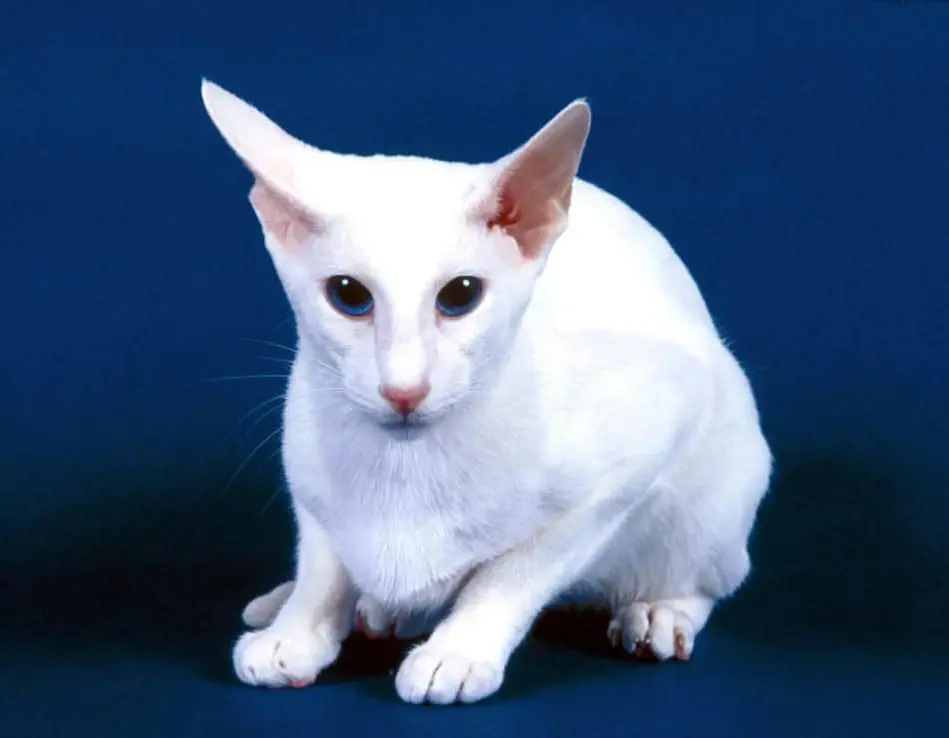Content |
|---|
Characteristics "Oriental shorthair cat"
Coexistence is important that you have with your new friend. Before considering the acquisition of a cat of the breed "Oriental shorthair cat" you know certain factors. You must take into account their character, their need for exercise, their interaction with other pets, their care and if you have small children, their level of tolerance towards them.
Joy5.0 out of 5 stars (based on 1 review)
|
Activity level4.0 out of 5 stars (based on 1 review)
|
Friendliness to other pets3.0 out of 5 stars (based on 1 review)
|
|---|---|---|
Friendliness to children3.0 out of 5 stars (based on 1 review)
|
Grooming requirements1.0 out of 5 stars (based on 1 review)
|
Vocality4.0 out of 5 stars (based on 1 review)
|
Need for attention5.0 out of 5 stars (based on 1 review)
|
Affection towards its owners4.0 out of 5 stars (based on 1 review)
|
Docility1.0 out of 5 stars (based on 1 review)
|
Intelligence5.0 out of 5 stars (based on 1 review)
|
Independence1.0 out of 5 stars (based on 1 review)
|
Hardiness2.0 out of 5 stars (based on 1 review)
|
History
In the past, as the story goes, the cats of blue eyes and pattern “pointed” were owned by royalty and kept in the Siam Royal Palace. But, the race of Siamese cat it was just one of several indigenous varieties in the area.
The “Poems from the Book of the Cat”, a manuscript of verses and paintings written in the city of Ayutthaya, Siam, sometime between 1350 d.C., when the kingdom was founded, and 1767 d.C., when the city was destroyed by the invaders, describes and shows a variety of cats native to the area. Among them are solid black cats, the black and white bicolor, solid browns and solid blues, as well as cats with the restricted point color pattern. The color-restricted cats portrayed in the book had slender bodies and legs, large ears and sharp snouts, similar to the current ones Siamese and related breeds.
The first cats brought to England from Thailand were often solid brown or solid blue., or two-color black and white, as well as of “colorpointed“. These blue cats, browns and bicolored became very popular in Europe in the decade of 1890. But, in the decade of 1920, the dot pattern blue-eyed cat became the Siamese norm in Britain, and interest in the other varieties decreased.
The Oriental shorthair cat today does not come directly from Thailand, but a hybrid of Siamese cat mixed in the years 50 and 60. The creation of the breed was deliberate: breeders with a flair for coloration and breeding patterns, set out to create a breed of cat that would look and act like the Siamese cat, but that was profusely adorned with a wide range of colors and designs.
In the Decade of 1950, british breeders crossed siamese cats with short-haired domestic cats and the Russian Blue Cat.
At the end of the decade 1960, American breeders, fascinated by Oriental shorthair cat British, they took over and crossed Siamese, short-haired domestic with the Abyssinian cat to create a new look. Body style wasn't sacrificed for color and pattern, and the backcrosses with the Siamese preserved type and personality traits.
The breeders of the Oriental shorthair cat met with initial reproaches from breeders of Siamese, who resisted, in the best case, to the idea of another type hybrid Siamese, but, since the way had already been paved by the breeders of the Colorpoint shorthair cat, that obtained the acceptance of the CFA in 1964, the opposition did not prevent the Oriental shorthair cat gain ground.
The Oriental shorthair cat became popular very quickly, and their demand increased (at the beginning). In 1972, the CFA accepted the Oriental shorthair cat for registration, and granted him full status in 1977. Since then, its popularity has grown rapidly and it has become one of the short-haired breeds More popular.
The Oriental Longhair cat proceeds of the Oriental shorthair cat; the result is a cat that has the same wide range of colors and patterns as the Shorthair, but with a semi-long coat like that of the Balinese cat.
Since the Siamese cat and the Colorpoint longhair cat They had reference to Balinese cat longhair, it seemed only fair that he Oriental shorthair cat had his own variant of long hair: a breed with a long body, slim and classy, a silky coat and a full palette of colors and patterns to choose from.
The Oriental Longhair cat developed at the end of the years 70 mixing the Oriental shorthair cat with the Balinese cat. The breed obtained official recognition in 1985, when TICA accepted them with full status, and were accepted for registration by the CFA in February 1988. The breed was gaining popularity, appealing to cat lovers who wanted the sleek body type and personality of the Siamese, the style of Balinese cat, and the myriad colors and patterns of the Oriental shorthair cat.
In 1995, the Oriental shorthair cat and the Oriental Longhair cat they became a single race called Oriental Cat. A new color class was also accepted for the Oriental, the bicolor.
Popularity of "Oriental shorthair cat"
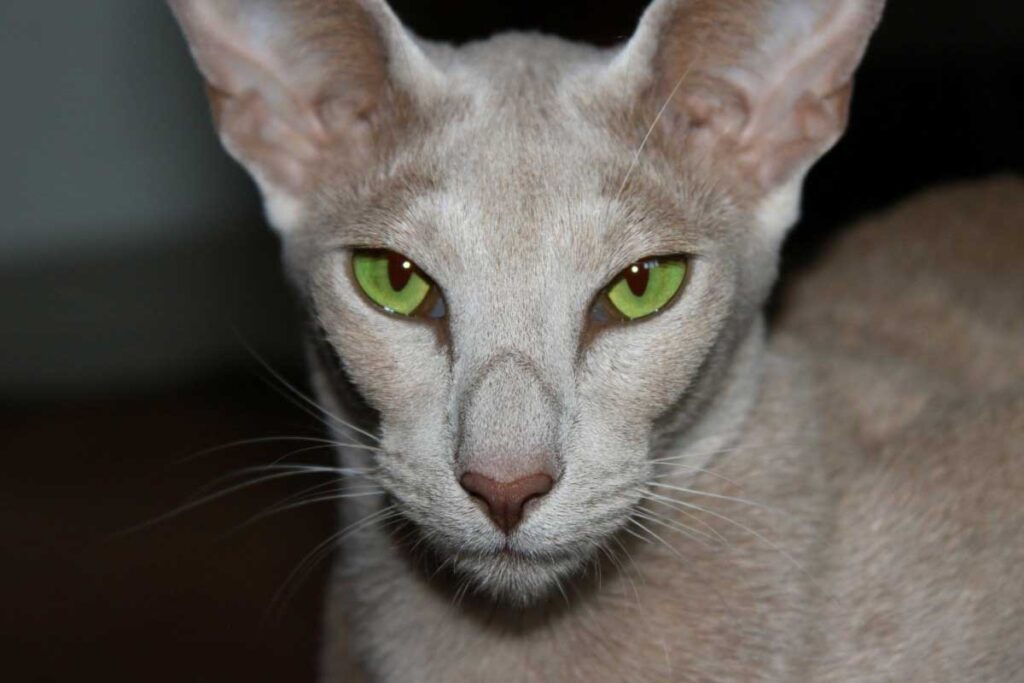
The development and dissemination of Oriental shorthair cat has been facilitated by the fact that it was fairly quickly recognized by most of the major official feline bodies. It also, its impressive diversity of colors and designs makes it able to attract many people. If to this we add his good character and his attachment to humans, it is easy to understand why it is very attractive and successful.
Like this, today there are many hatcheries in the four corners of the world, mostly in Western Europe and North America.
In France, since the beginning of the years 2000, are recorded annually between 250 and 350 kittens of Oriental shorthair cat in the Official Book of Feline Origins (LOOF). This figure places it even slightly above its ancestor the Siamese cat.
It is far from the same success in Switzerland, since the number of annual registrations in the Fédération Féline Helvétique (FFH) barely around ten. This is a clear decrease compared to the second half of the years 90, when the number of registrations was between 50 and 100. The decline had already begun in the decade of 2000, with an average of 40 registrations per year, but it was accentuated in the following decade. But, the Oriental Longhair cat is still lagging, with zero records in some years.
In the United Kingdom, the number of annual registrations Oriental shorthair cat in the Governing Council of The Cat Fancy (GCCF) has been reduced by more than half, going from more than 1.400 in the mid 90 some 600. But, the breed remains around 7th place in the ranking of the most popular cats in the country. Once again, the Oriental Longhair cat is far behind, with close to 5 times fewer births per year.
In United States, it is not possible to have statistics only for the shorthair cat, Since the Cat Fanciers’ Association (CFA) consider the Oriental shorthair cat and the Oriental Longhair cat like two varieties of the same breed: the Eastern. In any case, it is clear that the Oriental remains one of the top ten most popular breeds in the country, based on annual CFA registration figures. Although these figures include both longhair cats as the shorthair cats, it is likely that the majority of the breed's population is made up of the latter.
Physical characteristics
The Oriental shorthair cat has a body alto, elegant with long legs. Except for the fur and the color of the eyes, looks like Siamese cat throughout.
Its body it is medium size, long and tubular. His shoulders and hips are equal in width. Its bone structure is fine and has a delicate overall appearance. But, it is neither fragile nor flimsy, but that, on the other hand, he is much more muscular, dense and heavy than you might think at first glance. Its back It is prolonged with a long, fine tail that ends in a point.
The legs they are big, slim and muscular, with feet small and oval.
The head it is medium in size and triangular in shape, resting on a neck long and thin that gives it a haughty bearing. The skull and the forehead are flat or slightly rounded.
The ears, large and wide at the base, they are widely separated and perfectly prolong the triangle formed by the head.
The eyes they are almond shaped, medium-sized, wide apart and sloping towards the nose. They are as intense green as possible. A blue eye, one green eye – are possible in bicolor or white-coated individuals. The latter can also have both blue eyes.
Side view, the nose it's long and straight. Head on, perfectly fits the general triangular shape of the head, without having a narrow tip. The chin follows the line of the nose.
The cheeks they are flat, but double chin is acceptable in adult men.
Last, the fur of the Oriental shorthair cat is too short, dense, very closed, fine and silky. While the Siamese cat it can only be colourpoint, that is to say, have a solid body color and darker limbs, the Oriental shorthair cat has a very diverse appearance, with more than 300 color combinations and patterns. But, the colourpoint characteristic of Siamese cat, the typical vision of Tonkinese cat and the sepia of the Burmese cat.
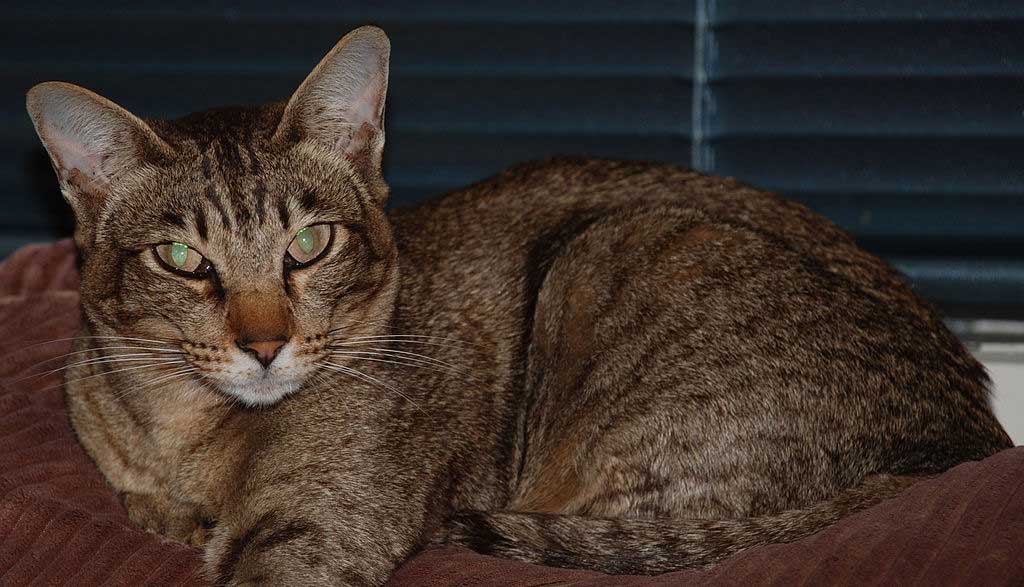
Size and weight
- Male size: Of 30 to 30 cm.
- female size: 30 cm.
- Male weight: 4 to 6 kg
- female weight: 3 to 4 kg
Breed standard
The breed standards are documents established by official bodies that list the conditions that a dog must meet. Oriental shorthair cat to be fully recognized as belonging to the race:
- Standard FIFé (Fédération Internationale Féline)
- Standard LOOF (Livre Officiel des Origines Félines)
- Standard AFC (Association Féline Canadienne)
- Standard TICA (The International Cat Association)
- Standard CFA (The Cat Fanciers’ Association)
- Standard GCCF (The Governing Council of the Cat Fancy)
Varieties of "Oriental shorthair cat"
Is he Oriental shorthair cat a variety of Siamese cat or a different race? This controversy is still valid today in the official organisms.
The Oriental shorthair cat was created as a result of the deliberate desire of British breeders to develop the breed siamesa with a greater variety of coat colors. So, share a common genotype (that is to say, hereditary characteristics) with the Siamese and a similar general phenotype (that is to say, appearance). If we refer to the scientific definition of race, things are very clear: since it only differs from Siamese in the coat or in the color of the eyes and that is far from enough to speak of a different race, is simply a variety of the Siamese.
Some official bodies share this opinion. Is the case, in particular, of the Fédération Internationale Féline (FIFé), the International Cat Association (TICA) or the Livre Officiel des Origines Félines (LOOF) French, who consider the Oriental shorthair cat as a variety of the group of Siamese breeds.
Other, as the American Cat Fanciers’ Association (CFA), the Canadian Cat Association (CCA) and the Governing Council of The Cat Fancy (GCCF), consider that the differences are sufficient to justify the recognition of the Oriental cat as a race in its own right, which in turn comes in two varieties, depending on the length of the fur: the Oriental shorthair cat and the Oriental Longhair cat.
In any case, thanks to random genetics, the same litter can mix the Siamese Cat, to the Balinese cat, Oriental shorthair cat and to the Oriental Longhair cat. This is all the more true as most organizations, like the LOOF, allow almost all possible crosses between these different cats.
Also called Javanese cat (Colorpoint Longhair) or mandarin cat, the Oriental Longhair cat appeared at the end of the years 70, when American breeders decided to cross the Oriental shorthair cat with the Balinese cat, a version of long hair cat of the Siamese, to give rise to a longhair cat equivalent of the oriental shorthair.
The only difference between the two cats is the length of their fur.; for the rest, have the same physical characteristics and the same character.
For some organizations, como la Cat Fanciers’ Association (CFA) or the Canadian Cat Association (CCA), they are two varieties of the same breed: the Eastern.
For others, what do you consider Oriental shorthair cat as a simple variety of the Siamese cat, the Oriental Longhair cat is also a variety of the latter. This is the focus of the Fédération Internationale Féline (FIFé), for example.
Last, the fact that it is more recent and less widespread explains why some organizations do not recognize it at all. This is the case of the French LOOF.
Character and skills
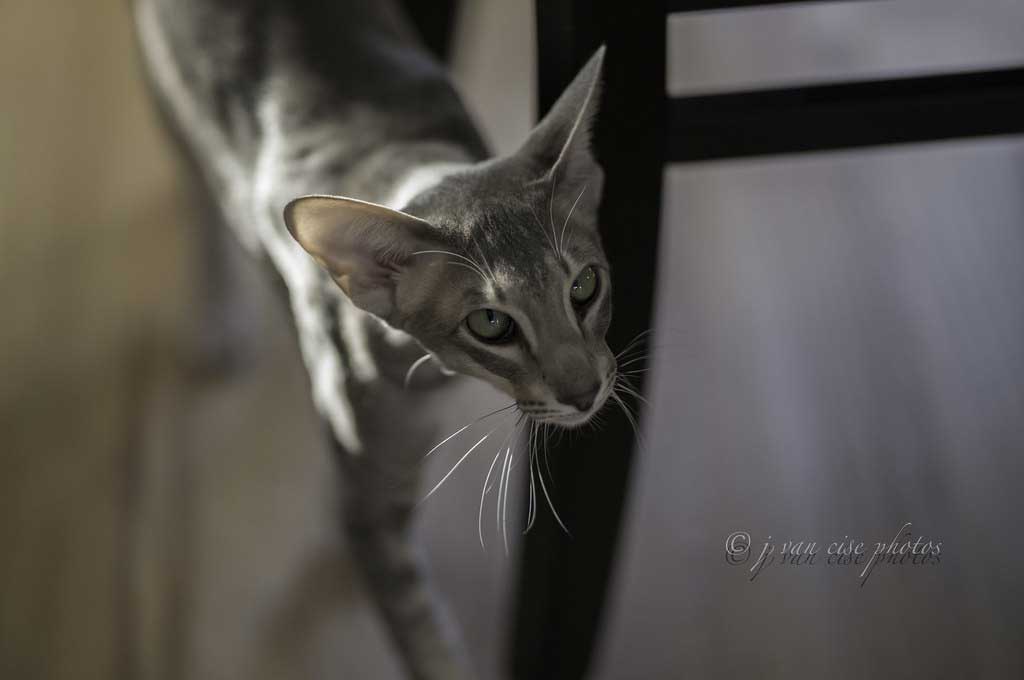
The temperament of Oriental shorthair cat is very similar to his ancestor the Siamese cat.
Without being so exclusive with his master like this, he is still quite possessive and absolutely needs contact with his family to live in a balanced way. It is also a good playmate for children. But, to avoid accidents, it is absolutely necessary to avoid leaving him alone with a small child, without adult supervision. This is valid for any breed of cat.
Although they get along with all the members of their family, they usually have a favorite person, usually the one that takes care of them the most. They tend to follow them everywhere, giving them a lot of love, such as snuggling into your lap or sleeping in your bed. You also communicate with her orally: like the Siamese, The short-haired oriental is very talkative. Has a very wide range of sounds, and the meow is an essential means of communication for him.
So, this cat is very attached to its owner and needs the same to happen to thrive. Thus, the owner should interact with him as often as possible, either playing, stroking or talking to him.
Like any cat, the Oriental shorthair cat has its moments of independence. But, although sometimes he likes to sit quietly in his corner, a bit off the beaten path, he always prefers his master to be in his field of vision.
Sociable and outgoing, does not like to be alone for a long time. When left alone, you need to have interactive toys that allow you to develop your skills and keep you busy. This prevents you from finding other interests, like turning the house upside down or playing with toilet paper, that unwinds and grinds with relish.
Sharing a home with another cat can also be a way to keep it entertained during the absence of its owners, and thus make them more bearable. In fact, he gets along very well with them, as long as it remains the dominant of the group. He knows how to impose his authority in his relationships with other cats, both at home and on your walks, and does not hesitate to fight if necessary.
You can also easily cohabit with a canine representative, and having your cat live with a dog is another option to consider, especially so that he can entertain himself when his humans are not around. But, it is important to choose a breed of dog that gets along well with cats. In any case, Coexistence works best when both parties are used to it from an early age. Otherwise, things should be done very gradually, to maximize the chances of things going well.
In any case, it would not be advisable for a Oriental shorthair cat lived under the same roof as a small rodent or bird. They have a strong hunting instinct and would soon be seen as prey.. If the situation occurs, it is essential never to leave them together unattended and to take all precautions to protect the small animal, otherwise the experiment may be a failure. When they have access to nature, your hunting instincts can also unleash, and they are happy to bring their loot to show how well they have worked.
Very energetic, agile and playful, the Oriental shorthair cat needs space to run, either in a large flat or in a house with a garden. On this last case, it is good that a cat flap allows you to go out to play or enter and be with your family. Given their need for interaction with their humans, it is important not only to provide him with toys and entertainment, but also spend time playing with your cat every day. This is especially true because they are playful throughout their lives., to the point that it doesn't take much to amuse them: for example, they enjoy giving back to its owner an object that has been thrown at them.
It is also important to provide him with a cat tree so that he can observe his surroundings and occasionally rest in it., as well as a scratching post. The latter is especially important if you live in an apartment, as it can scratch furniture or curtains.
The Oriental shorthair cat you are curious and smart. They have a talent for opening doors, drawers and bags, steal and hide the things that interest them. Although he usually understands what is forbidden, his stubborn and vindictive character makes him quickly recalcitrant when it comes to respecting them. Like this, even when his master has made it clear that something is not allowed, does not hesitate to return to the load. So, you need to be patient, consistent and firm with him, insisting everything necessary to respect you.
Last, despite his outgoing character, the Oriental shorthair cat may be afraid of strangers and hide when its owner invites strangers into the house. To avoid this, it is convenient to socialize the dog from an early age, that is to say, get used to meeting all kinds of people. This also applies to other dogs: the more dogs you meet at a young age, better it will be when you know them as an adult.
Health
"Oriental shorthair cat" |
||
|---|---|---|
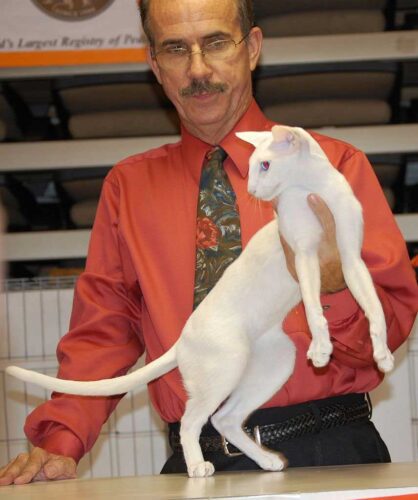 | ||
The Oriental shorthair cat enjoys, in general, Of good health: most representatives of the breed get rid of major problems.
They can withstand high temperatures, but they are especially sensitive to cold. It is important to prevent them from getting cold, since the catarrh of the cats, there coryza, can have lifelong effects, especially if they are small or older. When the temperatures are low, it is important that your cat has a warm place to snuggle and can enter at any time to warm up instead of staying outside.
It also, although the short-haired Oriental enjoys, in general, Of good health: most representatives of the breed get rid of major problems.
They can withstand high temperatures, but they are especially sensitive to cold. It is important to prevent them from getting cold, since the catarrh of the cats, there coryza, can have lifelong effects, especially if they are small or older. When the temperatures are low, it is important that your cat has a warm place to snuggle and can enter at any time to warm up instead of staying outside.
It also, but the Oriental shorthair cat is generally healthy, not immune to certain diseases, many of which also affect his ancestor the Siamese cat.
The diseases to which they are most prone are:
- The renal amyloidosis, an inherited disease that causes an abnormal buildup of amyloid-type proteins in the kidneys, leading to irreversible and fatal kidney failure if left untreated. If caught early, the effects of the disease can be treated and the cat can lead a relatively normal life;
- The asthma, a bronchopulmonary disease that causes severe respiratory attacks in which the cat suffers attacks of dry cough and stretches its neck because it has difficulty breathing. It is caused by an allergic reaction to certain substances in the environment, both natural and chemical. Long-term treatment can improve living conditions, but it doesn't solve the root problem, since for this it would be necessary to identify and eliminate the problematic substance, what is rarely possible;
- strong> Aortic stenosis, congenital cardiovascular malformation consisting of a narrowing of the aorta. Causes a heart murmur and can be treated with surgery or beta-blocker therapy;
- The congenital megaesophagus, a condition in which the esophagus has a delay in its development. Produces regurgitation of food, and weight loss due to the affected animal not being able to feed itself sufficiently. This may improve on its own as the cat gets older. Otherwise, certain eating habits should be adopted to reduce the risk of regurgitated food ending up in the lungs, since it can be deadly;
- The progressive retinal atrophy, an incurable inherited disease that causes progressive loss of vision, reaching total blindness in cats. It is difficult to detect until it has reached an advanced stage, that is to say, the animal begins to collide with everything due to the deterioration of its sight;
- Genetic strabismus, which weakens visual acuity and reduces the cat's field of vision. There is no treatment to correct this anomaly., which in fact is not particularly disabling;
- Psychogenic alopecia, causing loss of hair in a large or small area of ​​the body as a result of constant licking. It is a psychosomatic illness, that is to say, caused by a mental disorder. The latter is related to past trauma (especially at a young age) or with a concern in the direct environment. It is essential to seek the help of a behavioral professional to identify the source of the problem and hope to remedy it..
It also, the Oriental shorthair cat he's a bit gluttonous, so you have a certain propensity to obesity. Obesity is not without its health effects: can both aggravate existing problems and create new ones.
In any case, as many of the diseases to which the breed is prone are or may be hereditary, go to a serious breeder of a Oriental shorthair cat is the best way to ensure that the chances of adopting a healthy pet are good and are maintained. In fact, is not content to guarantee the socialization of puppies from a very young age, Rather, a professional worthy of the name is concerned that they do not inherit a hereditary defect from their parents. As such, systematically performs various genetic tests on proposed breeders and excludes those at risk. So, must be able to present the results of these tests, in addition to a certificate of good health issued by a veterinarian and the details of the vaccinations administered, registered in the animal's health or vaccination card.
Once adopted, it is the owner's responsibility to take care of their cat throughout its life. One of the best ways to keep your cat healthy is to take him to the vet regularly for a full checkup.. This should be done at least once a year, and even more often as the animal ages. Times, these visits allow the early detection of a problem, which allows to treat the cat in the best possible conditions, and can also allow cat vaccinations to be done at the same time.
At the same time, the owner must also give his animal adequate antiparasitic treatments throughout the year, so you never stop being protected. This also applies to indoor cats, that are not completely free of parasites.
Grooming
"Oriental shorthair cat" |
||
|---|---|---|
 | ||
The Oriental shorthair cat it is a breed of cat that does not require much care, and this is especially true for their fur. Brushing the coat every fortnight with a soft bristle brush is enough to remove dead hair..
It is also necessary to examine and clean the ears with a damp cloth once a week to clean them and prevent dirt from accumulating in them., which could lead to infections such as otitis.
At the same time, you have to check the eyes and rub a damp cloth in the corner if they are dirty, to reduce the risk of infection.
It is also essential to brush your cat's teeth at regular intervals., ideally every day, and preferably no less than once a week. This will limit plaque buildup., that can cause not only bad breath, but also more or less serious diseases.
Last, the length of the claws of the Oriental shorthair cat must be checked every month. If they get too long, they can get in the way, break and even injure the dog. This is less likely to be a problem for an individual with access to the outside.: natural wear and tear should be enough to file down the claws, although it is still necessary to check from time to time that this is the case. On the other hand, for an indoor dog, a monthly cut is usually necessary. By the way, this does not exempt you from providing a scratching post so your dog can scratch on it and not on furniture.
Whether the fur, the ears, the eyes, teeth or claws, maintaining a Oriental shorthair cat not particularly complex. But, if they are not done correctly, not only can they be ineffective, but that, above all, can injure or even harm the dog. So, it is best to learn them the first time from a vet or professional groomer.
If done right, these cares can become, with the time, in a special moment between the two protagonists, especially if the owner takes the opportunity to hug his pet. In any case, things are more likely to go well if the animal is used to these different manipulations from a very young age.
Food
Like all other races, the Oriental shorthair cat you need a diet that perfectly meets your nutritional needs - both in terms of quality and quantity- depending on your age, your health and activity level.
Good quality industrial foods can perfectly meet these requirements, but in general the same cannot be said of human food. Unless carefully selected to meet the needs of the animal, unlikely to contain exactly what you need. These may include, Giving him the leftovers from the table or letting him help himself to the garbage is not usually a gift. This is especially true because, plus some foods popular with humans are toxic to cats, The Oriental with short hair has a tendency to be overweight.
The latter also means that, unlike most other cats, it is better to get used to fixed foods from the beginning. Leaving food out all day would soon become a problem., due to their inability to regulate themselves.
Your propensity for obesity also makes it important to control your weight by weighing it once a month.. In case the increase is confirmed or even amplified in the following measurements, it is advisable to use the experience of a veterinarian, since the diet or activity level of the animal are not necessarily to blame: excess weight can be a symptom of a disease, or be caused by medication. Only a professional can clarify the situation and indicate how to remedy the problem.
Like any other cat, the Oriental shorthair cat must have fresh water available at all times.
For sale "Oriental shorthair cat"
The price of a Oriental shorthair cat usually oscillates between 800 and 1500 EUR.
whatever the country, the amount charged varies depending on the reputation of the kennel, from the lineage from which the animal comes, but also and above all its intrinsic characteristics, starting with their degree of approach to the breed standard. This explains why there can be significant price differences within a litter.
|
|
|
|---|
